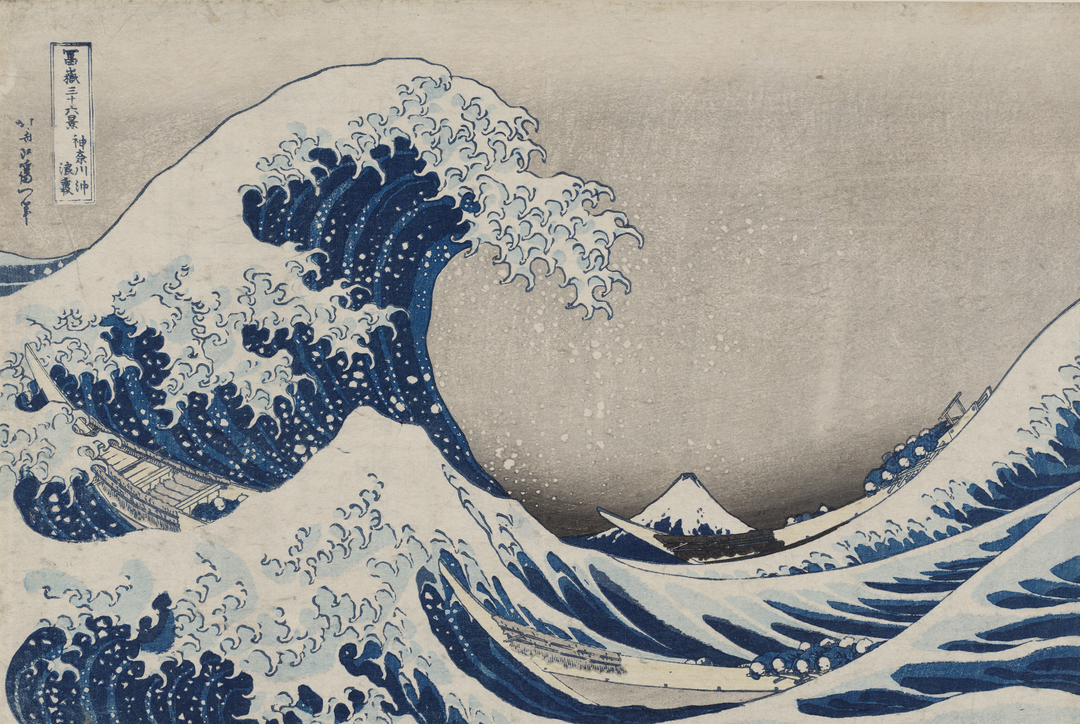Hokusai Smartphone Tour: Under the Wave off Kanagawa

If there’s one work by Katsushika Hokusai you’ve definitely seen before, it’s Under the Wave off Kanagawa. More commonly referred to as the Great Wave, this iconic woodblock print has been cited everywhere from book covers to Lego sets, anime, and even an emoji (🌊). To offer a closer look at this infamous print, Dr. Sarah Thompson, Curator of Japanese Art at the Museum of Fine Arts, Boston, called in an expert: Dr. Christine Guth.
On the fourth stop of the free smartphone tour of Hokusai: Inspiration and Influence from the Collection of the Museum of Fine Arts, Boston at SAM, Dr. Guth, author of Hokusai’s Great Wave: Biography of a Global Icon, explains how this work became a global icon. Put plainly, the Great Wave’s strength is in its broad applicability across time and space.
Many first time viewers of the original print find themselves surprised by its small size, she explains, as the work has been reprinted an infinite number of times in various proportions, skewing our perception of its original size. However, with its commanding depiction of a wave, it’s been interpreted a multitude of ways, including as an expression of the powerful force of nature.
Listen to the recording now for Dr. Guth’s full discussion of the Great Wave. All seven stops on the free audio tour of Hokusai: Inspiration and Influence can be accessed via QR code in SAM’s galleries or on our SoundCloud. The exhibition closes in just over a month—get your tickets to see it before it’s too late!
Under the Wave off Kanagawa, about 1830–31
DR. SARAH THOMPSON: Dr. Christine Guth is one of the most distinguished scholars of Japanese art in the English-speaking world. Her book Hokusai’s Great Wave: Biography of a Global Icon was a huge help to me in planning this show, and I am delighted that she has agreed to tell us more about it in person.
DR. CHRISTINE GUTH: So, maybe this is the first time you’ve looked at this print in the original. And when you see it in reproductions you have the impression that it’s a huge work of art, but it’s very small. And it wasn’t intended as a unique work of art, but was printed many, many times. There were probably about 3,000 impressions made during Hokusai’s lifetime. It had a huge impact on Hokusai’s contemporaries, but they would’ve looked at it very differently than we do today. For instance, as you look at the print today, probably the first thing you notice is the giant cresting wave with its rather menacing claw-like extensions.
And then, you see the tiny Mount Fuji in the background. Now, certainly Hokusai’s Japanese contemporaries would have seen that as well, but they may have paid more attention than we do to the boats cutting through the waves, because Hokusai intended this image to represent a particular moment in time and place. And what it suggests is boats carrying the first catch of bonito of the season from the fish market in Osaka to Edo, because fresh sashimi made from bonito was a real delicacy.
One of the distinguishing qualities of the series of Thirty-six Views of Mount Fuji is not only that it shows the mountain from many different vantage points, but it captures it at different seasons and different points in the day. And I think that this print evokes that in the sense that the first catch was usually in the fourth month. That would be May today. So, there’s a very strong seasonal quality to the series. Today when people look at this print, some people see it as threatening and some people see it as an expression of the force of nature. And in fact, that was used very often after the terrible tsunami in Japan in 2011. And one of the great strengths of this print is the way it can speak to so many people across time and space. That’s what’s made this a global icon.
– Lily Hansen, SAM Marketing Content Creator
Image: Under the Wave off Kanagawa (Kanagawa-oki nami-ura), also known as the Great Wave, from the series Thirty-six Views of Mount Fuji (Fugaku sanjūrokkei), about 1830–31 (Tenpō 1–2), Katsushika Hokusai, Japanese, 1760–1849, woodblock print (nishiki-e); ink and color on paper, Museum of Fine Arts, Boston, William Sturgis Bigelow Collection, Photograph ©️ Museum of Fine Arts, Boston.